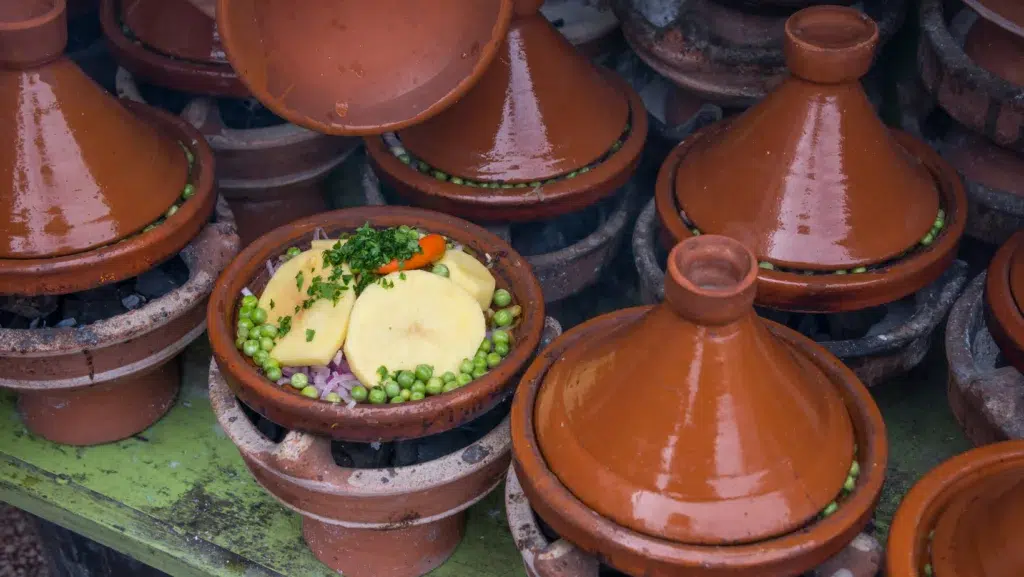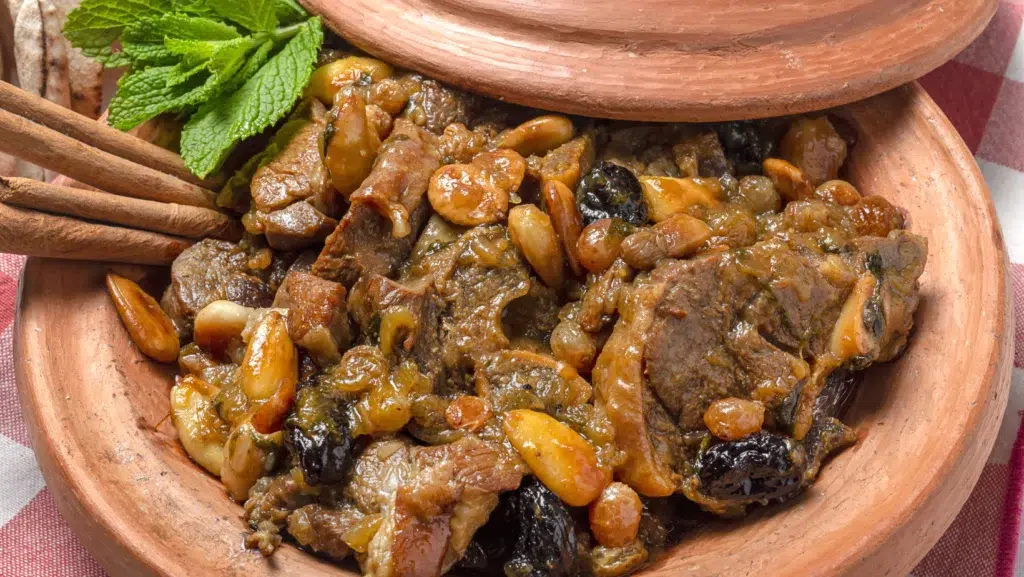Some links on this page are affiliate links. This means we may earn a commission at no additional cost to you if you click through and make a purchase, you can check our Affiliate Disclosure. Thank you for your support!
We’d like to welcome you to the aromatic, colorful, and spice-filled world of Moroccan cuisine, which has captured the attention of foodies everywhere! 🌍 At the heart of this culinary tradition sits the Moroccan tagine, not just a dish but a symbol of Morocco’s rich culture and history.
Moroccan Tagines are much more than just a way to cook food; they’re a celebration of communal eating and a testament to the art of slow cooking. These dishes, named after the unique clay pot they’re cooked in, bring together a variety of fresh ingredients and bold spices, simmering them to perfection. 🥘
In this blog, we’ll dive into the exciting world of Moroccan Tagines. We’re talking about everything from their deep-rooted history to the diverse types you can cook. You’re in for a treat whether you’re an experienced cook or a naïve gourmet! Get ready to explore how these iconic dishes are prepared and discover some tips and tricks to bring the essence of Morocco right into your kitchen. Let’s get started! 🌟

Understanding Moroccan Tagines
History and Cultural Significance of Tagines
Let’s start with a little history lesson. Tagine cooking began in North Africa, a region known for its rich and diverse food traditions. These dishes are more than just meals; they’re a crucial part of Moroccan culture and daily life. Imagine families and friends gathering around a steaming tagine, sharing stories and enjoying the meal together. That’s the essence of Moroccan hospitality! 🌍
Tagines have been around for centuries, and they’ve always been about bringing people together. They’re not just pots; they’re a symbol of Moroccan heritage, showing the world the warmth and generosity of Moroccan hospitality.
The Unique Cooking Method of Tagines

Now, let’s talk about how Moroccan Tagines are cooked. It’s all about slow cooking. Slow and steady wins the race here! By simmering ingredients over low heat, tagines bring out the best in every spice, herb, and piece of meat or vegetable. The result? A dish that’s bursting with flavor, tender and rich. 🍲
But what about the pots themselves? Tagine pots are special. They come in two parts: a flat, circular base where you place your ingredients, and a cone-shaped lid that goes on top. This unique shape helps circulate heat and moisture, cooking the food evenly and locking in all those delicious flavors. You’ll find tagines made of clay or ceramic, each with its own unique character. Some are simple and functional, while others are ornately decorated, turning cooking into an art form. 🎨
Types of Moroccan Tagines
Classic Meat Tagines

When it comes to Moroccan Tagines, the classic meat varieties are a must-try. They’re rich, hearty, and full of flavor. Let’s check out a couple of popular ones:
Lamb or Beef Tagines with Prunes, Almonds, and Spices: This is a showstopper! Imagine tender lamb or beef, sweet prunes, and crunchy almonds, all brought together with a mix of aromatic spices. You’ll be begging for seconds because of its delicious balance of sweet and savory flavors. 🍖
Chicken Tagine with Lemon and Olives: Here’s another favorite. Juicy chicken pieces, tangy preserved lemon, and olives make this tagine a taste sensation. The combination of citrusy, salty flavors with tender chicken is simply irresistible. 🍋🍗
Vegetarian and Vegan Tagines
Don’t worry, plant lovers, Moroccan Tagines have got you covered too! These veggie-friendly versions are just as tasty:
Seasonal Vegetable Tagines: Packed with whatever fresh veggies are in season, these tagines are a rainbow of nutrients and flavors. Think carrots, potatoes, zucchini, and more, all simmered to perfection in a fragrant spice blend. 🥕🥔
Chickpea and Sweet Potato Tagine: This one’s a hearty, filling option that’s perfect for vegans and vegetarians. Nutritious chickpeas and sweet potatoes come together in a spiced tomato-based sauce. It’s a comforting, wholesome meal that’ll satisfy everyone at the table. 🌱🍠
Whether you’re a meat-lover or a veggie enthusiast, Moroccan Tagines offer something for everyone. Ready to cook one up? Stay tuned for our next section on preparing your own Moroccan Tagine!
Preparing Your Own Moroccan Tagines
Getting ready to cook your own Moroccan Tagine? Awesome! Let’s dive into what you need to make these delicious dishes.
Essential Ingredients and Spices
First things first, let’s talk about the spices and ingredients that give Moroccan Tagines their unique taste:
- Spices: The stars of the show are spices like cumin, cinnamon, coriander, paprika, and turmeric. Each brings its own kick, warmth, or earthy flavor. Remember a pinch of saffron for that luxurious touch! 🌶️
- Key Ingredients: Apart from your main ingredient (like meat, chicken, or veggies), you’ll need onions, garlic, and maybe ginger for the base. Tomatoes, olives, preserved lemons, and dried fruits (like prunes or apricots) add depth and a hint of sweetness. And let’s remember the olive oil and fresh herbs for that final flourish! 🍅🌿
ALSO READ: Elevate Your Meals: A Power-Packed Guide to Seasonal Ingredients
Step-by-Step Guide to Making a Tagine
Now, let’s get cooking:
- Prep Your Ingredients: Chop your meat or veggies into bite-sized pieces. Dice your onions and mince your garlic.
- Build the Flavor Base: In your tagine pot or a heavy-bottomed pan, heat some olive oil. When the onions are soft and the herbs are fragrant, add the onions, garlic, and spices and continue to cook.
- Add the Main Ingredients: Put in your meat or veggies. If you’re using meat, brown it slightly. For veggies, give them a good stir to coat them in the spices.
- Add Liquids and Extras: Pour in some broth or water, enough to partly cover the ingredients. This is also the time to add things like tomatoes, olives, or dried fruits.
- Slow Cook: Put a lid on the pot and simmer it slowly This could take anywhere from an hour to a few hours, depending on what you’re cooking. The key is low and slow – that’s how all the flavors meld together beautifully. 🍲
- Finishing Touches: Just before serving, add a splash of fresh lemon juice and some chopped herbs like cilantro or parsley for a new pop of flavor.
Tips for Perfect Flavor and Texture:
- Balance Your Spices: Start with small amounts and adjust as you go. The goal is a harmonious blend where no single spice overpowers the others.
- Be Patient: The magic of a tagine is in the slow cooking. Don’t rush it – that’s when all the flavors come together.
- Experiment: Feel free to try different combinations of spices and ingredients. Tagines are very forgiving and adaptable to your taste.
And there you have it! With these tips, you’re well on your way to making a mouth-watering Moroccan tagine. Enjoy the process and the delicious results! 🌟
Serving and Enjoying Moroccan Tagines
Now that you’ve mastered the art of making a Moroccan tagine, let’s talk about how to serve and enjoy it to the fullest!
Traditional Side Dishes and Accompaniments

A Moroccan Tagines is almost a complete meal by itself, but a few sides can make it even more enjoyable:
- Bread: In Morocco, bread is not just a side dish; it’s a vital part of the meal. Use it to scoop up the delicious tagine sauce. 🍞
- Couscous: Fluffy couscous is a classic pairing with tagines. It’s perfect for soaking up all those tasty juices. 🥣
- Other Sides: Try some Moroccan salads or a side of rice. They add variety and freshness to your tagine meal. 🥗
How to Present and Serve a Tagine
Presentation is key! Here’s how to do it:
Please keep it in the Tagine: Serve your dish right in the tagine pot it was cooked in. It looks authentic and keeps the food warm.
Garnish: Sprinkle some fresh herbs or a few slices of lemon on top for a pop of color and flavor.
Communal Style: Place the tagine in the center of the table. It’s all about sharing and enjoying the meal together.
Pairing Tagines with Beverages
The right drink can complement your Moroccan Tagines beautifully:
- Wine Pairings: A medium-bodied red wine works well with meat tagines, while a crisp white wine pairs nicely with chicken or vegetable tagines. 🍷
- Non-Alcoholic Drinks: Mint tea is a traditional Moroccan choice. Its freshness balances the richness of the tagine. For something colder, try a glass of lemonade or a fruity mocktail. 🍹
And there you have it – your guide to serving and enjoying Moroccan Tagines. Whether it’s a special occasion or a cozy dinner at home, these tips will help you create a truly memorable Moroccan feast.🎉
ALSO READ: Discovering the Delight of Ful Medames: A Culinary Guide for Enthusiasts
Before we wrap up, let’s answer some frequently asked questions about Moroccan Tagines:
Do I need a tagine pot to make a Moroccan Tagine?
While a traditional tagine pot adds authenticity, you can still make delicious tagines using a heavy-bottomed pot or Dutch oven.
Can I make tagines if I’m a vegetarian or vegan?
Absolutely! There are many veggie-friendly tagine recipes that are just as flavorful and satisfying.
How do I store leftover tagine?
Leftover tagine can be stored in the refrigerator for up to three days and tastes even better the next day as the flavors meld.
Can I freeze a tagine?
Most tagines do indeed freeze well. Just remember to keep them in a sealed container.
So there you have it! Moroccan Tagines are not just meals; they’re an experience, a journey into the heart of Moroccan culture. Grab your spices, gather your friends and family, and start cooking up some magic today! 🎉
ALSO READ:Taste Adventures: Diving Deep into the World of Fufu Cuisine
Conclusion
We’ve journeyed through the delightful world of Moroccan Tagines, uncovering the secrets behind their rich flavors and cultural significance. 🌟
From understanding the history and cooking methods to exploring various types and learning how to prepare your own, we’ve covered a lot. We hope you’re now feeling inspired to try your hand at these iconic dishes. Whether it’s the classic meat tagines with their blend of sweet and savory or the hearty vegetarian options, there’s a world of taste to explore. 🍲
Remember, the beauty of Moroccan Tagines lies in their versatility. Feel free to experiment with different ingredients and spices. Make each tagine your own and enjoy the process of cooking as much as the eating.


